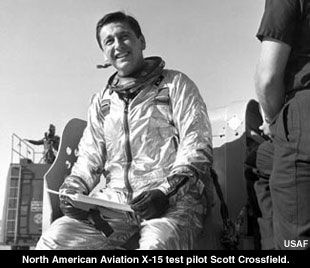|
|

|
Pilot Scott Crossfield killed in plane crash

April 20, 2006 — The first man to fly twice the speed of sound, Scott Crossfield was found dead today inside the wreckage of a single-engine plane he had been flying on Wednesday morning from Alabama to Virginia, authorities told the Associated Press.
Crossfield's Cessna 210A was found by search crews in the mountains northwest of Atlanta, Georgia on Thursday after radio and radar contact was lost at 11:15 a.m. EDT the day before. There were thunderstorms reported in the area, though the cause of the crash was not immediately released.
"Scott Crossfield was a pioneer and a legend in the world of test flight and space flight," said Mike Coats, Johnson Space Center Director. "The astronaut corps and all of NASA are deeply saddened by his death, but his legacy will be with us through the centuries."
Crossfield, 84, made aeronautical history in 1953 when he reached a speed of more than 1,320 mph, or Mach 2, in a Douglas D-558-II Skyrocket research aircraft. Taken aloft by a Boeing P2B Superfortress (the Navy's designation of the B-29), Crossfield climbed to 72,000 feet before diving to 62,000 feet, becoming the first person to travel at more than twice the speed of sound, according to his biography prepared by NASA.
A research pilot with the National Advisory Committee for Aeronautics, the predecessor to NASA, Crossfield flew nearly all of the experimental craft under test at Edwards Air Force Base, Calif., between 1950 and 1955. Over the five year period, he flew the X-1, X-4, X-5, XF-92A, and the D-558-I and -II. By the time Crossfield left Edwards to join North American Aviation in 1955, he had amassed more experience with rocket planes than any other pilot in the world.
At North American, Crossfield served as both a test pilot and design consultant for the X-15 rocket-powered plane. On June 8, 1959, he became the first to fly the aircraft on an unpowered glide from 37,550 feet. Three months later, Crossfield completed its first powered flight on September 17, 1959.
Shortly after launch on Crossfield's third X-15 flight, one of its engines exploded. Unable to jettison his propellants, Crossfield was forced to make an emergency landing during which the aircraft broke its back just behind the cockpit. He was uninjured and the airplane was repaired.
Crossfield subsequently qualified the first two X-15s for flight before North American turned them over to NASA and the U.S. Air Force. He flew the two aircraft a total of 14 times (not counting 16 captive flights), reaching a maximum speed of Mach 2.97 (1,960 miles per hour) and a maximum altitude of 88,116 feet.
"Scott Crossfield was a true pioneer whose daring X-15 flights helped pave the way for the space shuttle," said NASA Administrator Michael Griffin." Today, those of us in the aeronautics and space communities extend our condolences and deepest sympathies to Scott's family."
Crossfield continued working for North American until 1967, overseeing testing and quality assurance on the Hound Dog missile, Paraglider, Apollo Command and Service Module, and the Saturn V rocket's second stage.
In 1960, Crossfield published his autobiography (written with Clay Blair, Jr.), Always Another Dawn: The Story of a Rocket Test Pilot, covering his life through the end of the early X-15 flights.
Crossfield later held executive positions with Eastern Airlines and Hawker Siddley Aviation. From 1977 until his retirement in 1993, he was a technical consultant to the House of Representatives Committee on Science and Technology, advising its members on matters relating to civil aviation.
More recently, Crossfield served as technical adviser for the "Countdown to Kitty Hawk" project, which built and flew an exact reproduction of the 1903 Wright Flyer for the national centennial of flight celebration at Kitty Hawk in December 2003.
Born in Berkeley, Calif., on October 2, 1921, Albert Scott Crossfield attended the University of Washington in 1940 before joining the U.S. Navy in 1942. Commissioned an ensign in 1943, he spent six months overseas without seeing combat duty. While in the Navy he flew the F6F and F4U fighters, as well as SNJ trainers, in addition to a variety of other aircraft.
Crossfield graduated in 1949 with a degree in aeronautical engineering from the University of Washington. He earned a masters in aeronautical science the following year from the same university and received an honorary doctor of science from the Florida Institute of Technology in 1982.
Among his many honors were the Collier Trophy for 1961 from the National Aeronautics Association, presented by President John F. Kennedy at the White House in 1962, and the International Clifford B. Harmon Trophy for 1960, also presented by President Kennedy in the White House the year before.
He was inducted into the National Aviation Hall of Fame, the International Space Hall of Fame and the Aerospace Walk of Honor.
Upon his retirement in 1993, Crossfield was awarded the Distinguished Public Service Medal for his contributions to aeronautics and aviation over a period spanning half a century by NASA. |

© 2023 collectSPACE.com All rights reserved.
Questions? E-mail contact@collectspace.com

|
|

|

|
